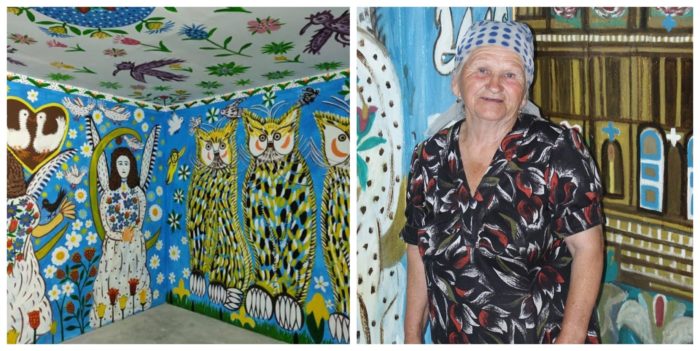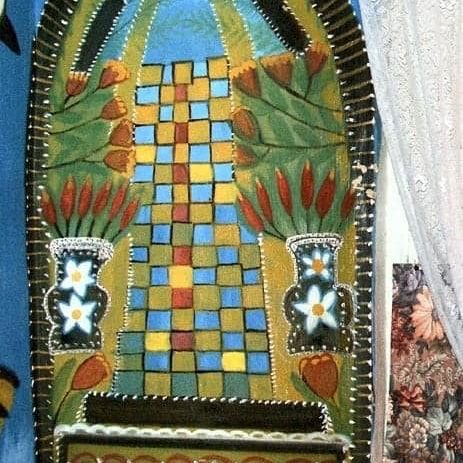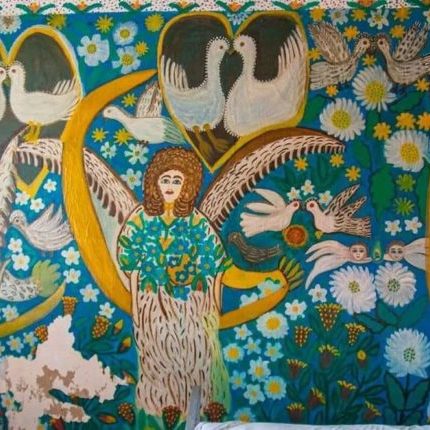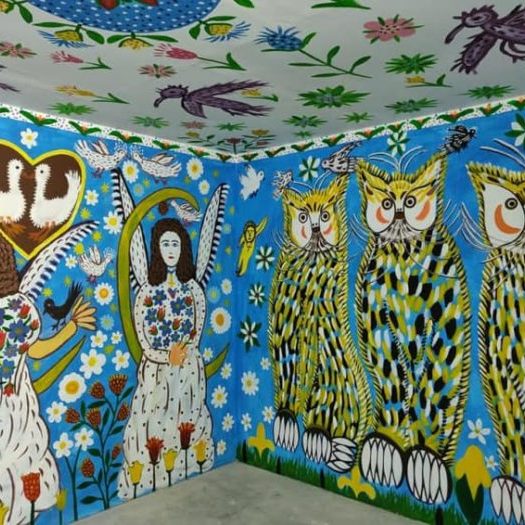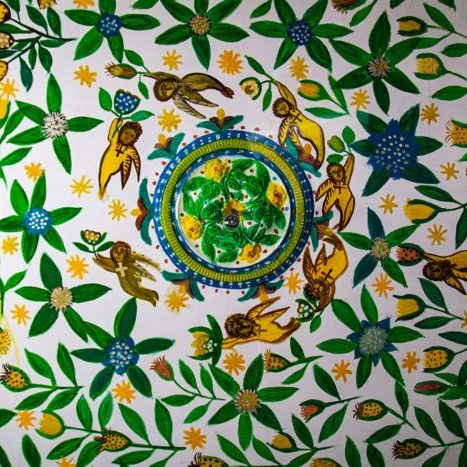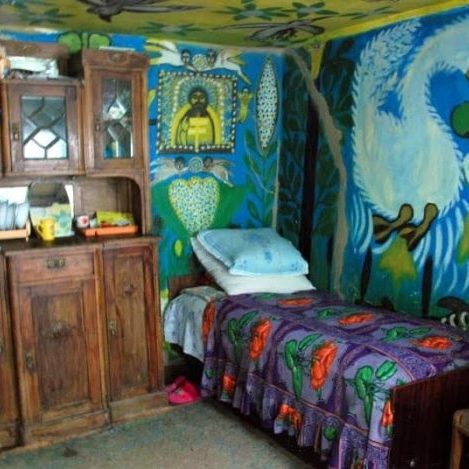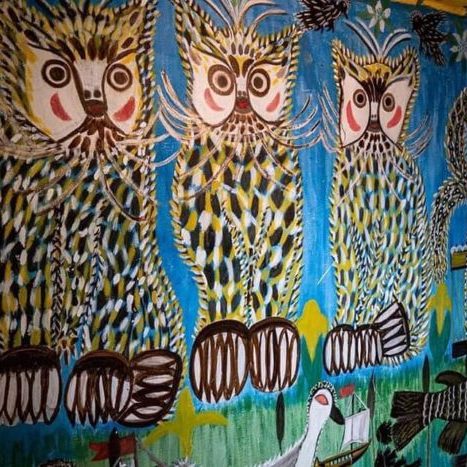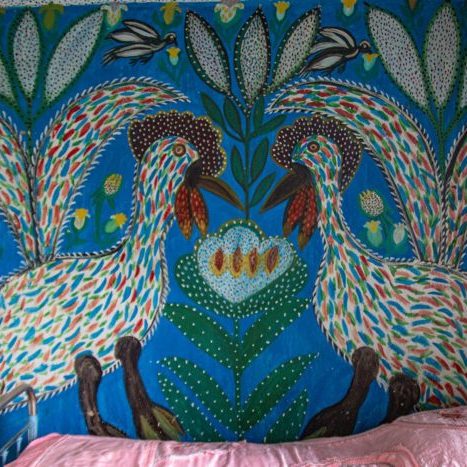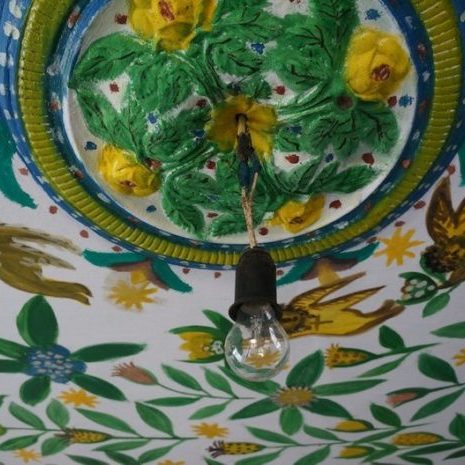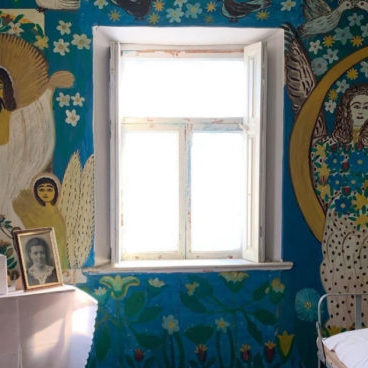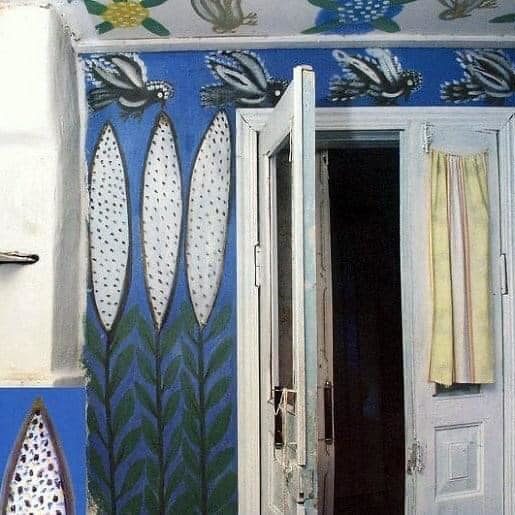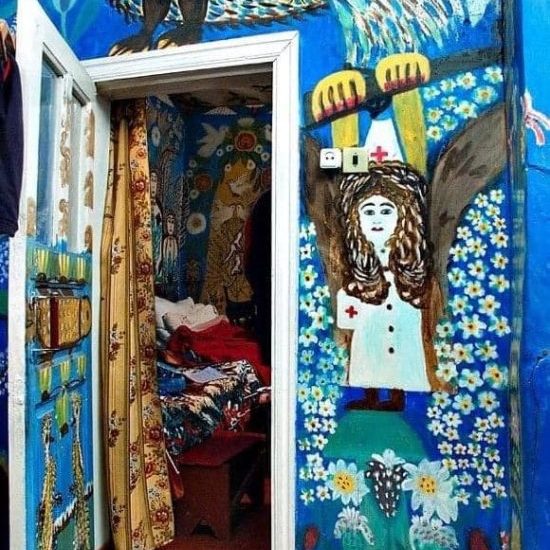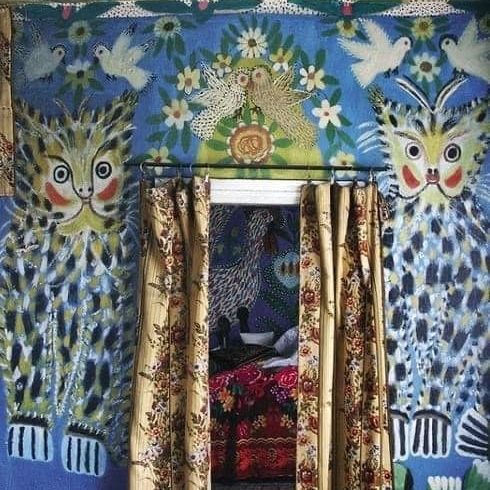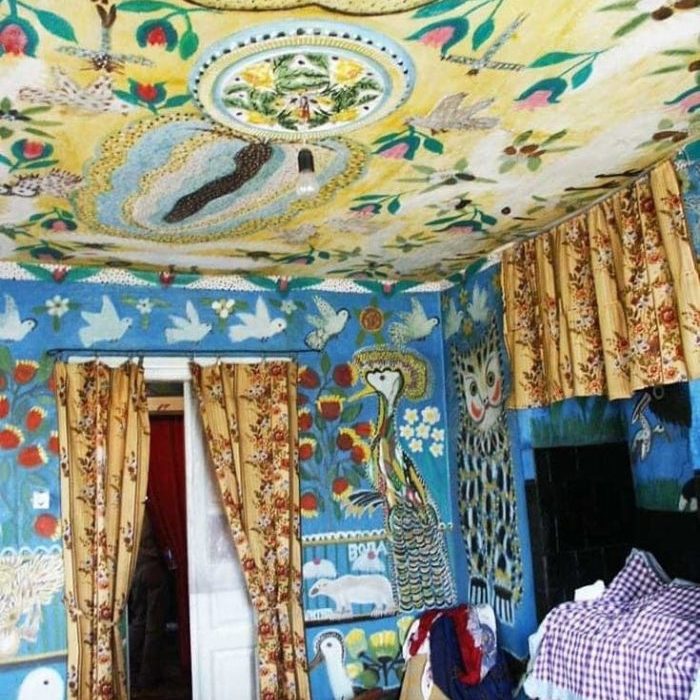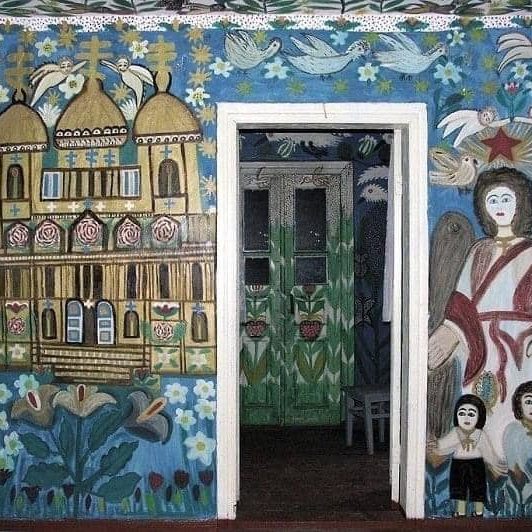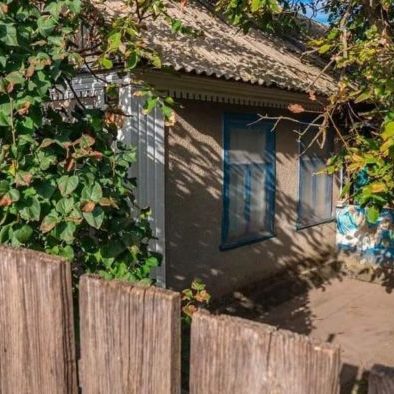Following the Kakhovka Dam explosion, the Polina Raiko Home-Museum was submerged underwater, as reported by Semen Khramtsov, an artist and the representative of the Polina Raiko Kherson Regional Charitable Foundation.
“I believe that the house with the frescoes is underwater. The neighbours said the first floor of their house was flooded, which means that Polina Raiko’s home will be submerged up to the roof.”
60-70% of the unique frescos of Ukraine's emblematic naive artist Polina Raiko were destroyed in the Kakhovka dam breach
The self-taught artist's house in Oleshky was adorned with mythical characters
📽️📷Semen Khramtsov, repr. of Polina Raiko charity fund https://t.co/E7gyoCMKry pic.twitter.com/RkC2oTiLXd— Euromaidan Press (@EuromaidanPress) June 16, 2023
Photos: Simon Khramtsov

The home-museum of Ukrainian folk artist Polina Raiko (1928 - 2004) in the Russian-occupied town of Oleshky is a distinctive cultural art gem of Kherson Oblast. This place was more than just a house and a home; it was a living masterpiece, adorned with fantastical paintings. Following Russia’s destruction of the Kakhovka Dam, it was confirmed that the legendary home-museum was directly threatened by rising waters.
According to Semen Khramtsov, the employees responsible for the art museum’s upkeep have been evacuated and are in a safe condition. He also mentioned that there is a pressing need for medicine, food and water.
The residence of art brut artist Polina Raiko is situated in the occupied town of Oleshky, which has been inundated by at least 90% flooding. Exiled mayor Yevhen Ryshchuk informed that the Russian authorities are refusing to evacuate residents and are prohibiting them from leaving the town on their own.
What makes Polina Raiko’s house so unique?
Polina Raiko’s house holds a special significance due to the fact that the artist herself adorned it with her own paintings. It stands as one of the most remarkable examples of Ukrainian naïve art, also known as brut art.
Raiko’s art is also characterized by its naivety and sincerity. It is not mere imitation or stylization created for commercial purposes; rather, it embodies Polina Raiko’s genuine passion for creative drawing.
Her artistic creations display various themes, including fantastical animals, depictions of her dreams, reinterpretations of family portraits captured in photographs, as well as scenes referencing the Second World War. Her murals also incorporated numerous religious images.
Art historian Tetiana Kochubynska provides insight into Polina Raiko’s work, stating:
“Having never received formal training in painting, Polina Raiko developed her own unique ‘iconography’. The placement of specific subjects within the house was directly linked to the corresponding rooms. For instance, a painting portraying her wedding can be viewed from the bedroom door, while leopard birds, guardians and protectors adorn the entrance to the bedroom. A small black dog is depicted near the stove, and a vulture symbolizing war is positioned above the hearth. Almost every composition within the rooms features a protective talisman in the form of paired storks, swans or doves.”
Today, it has disappeared…
Who was Polina Raiko?
The artist was born on May 28, 1928 in Oleshky and resided there throughout her entire life. She began her journey in painting during adulthood. It was in the aftermath of tragic life events - the passing of her husband and the subsequent loss of her daughter in a devastating car accident, followed by the arrest and subsequent death of her abusive son - that she dedicated her life to the art form. When her son was sentenced to a prison colony, Polina Raiko embarked on painting the walls of her vacant house at the age of 69, eventually transforming the entire residence into a comprehensive art installation.
With her meager pension, she began buying paints and brushes and, without any formal training or prior experience, transformed her humble abode into an expansive canvas, adorning its walls and even the ceiling, room by room. She chose to leave the exterior mostly untouched, only adding small fragments of her artwork, possibly due to her shy nature and innate unwillingness to open her doors to strangers.
Some people labeled her as strange and failed to grasp the depth of her artistic vision. She shared her paintings reluctantly with others, yet her heart would fill with joy if people appreciated her artworks, eagerly engaging in discussions about them.
Polina Raiko passed away on January 15, 2004 in Oleshky at the age of 75. Following her passing, her fans and admirers who were aware of her remarkable creations endeavored to preserve the house, seeking to prevent its demolition.
In 2008, artist Viacheslav Mashnytskyi established the Polina Raiko Kherson Regional Charitable Foundation with the purpose of preserving Raiko’s house and artwork. Prior to Russia’s large-scale invasion and flooding caused by the Kakhovka Dam blast, the foundation hosted festivals, artist residencies, and film shoots. However, the town of Oleshky is presently under occupation by Russian troops. During the occupation of Kherson Oblast, Viacheslav Mashnytskyi went missing.
Polina Raiko at the PinchukArtCentre
In 2018, the PinchukArtCentre in Kyiv featured an exhibition titled ‘A Space of One’s Own’ organized by the PinchukArtCentre Research Platform and curated by Tetiana Kochubinska and Tetiana Zhmurko. As part of this exhibition, photographs of Polina Raiko’s murals were displayed. These images were printed on the walls, creating an environment within the art centre that emulated the artist’s personal space.
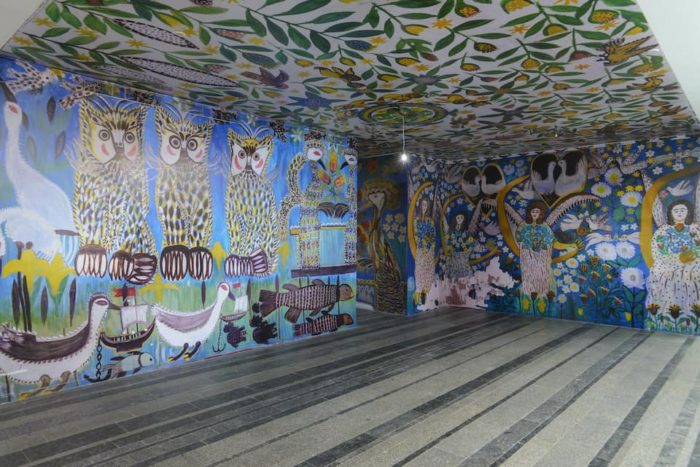
The exhibition 'A Space of One's Own'
aimed to present the narrative of Ukrainian art from the perspective of women artists. The title of the exhibition draws inspiration from Virginia Woolf’s renowned essay 'A Room of One's Own' (1929), in which the author challenges the conventional understanding of a woman artist’s position and role within a predominantly male-dominated world. By embracing this title, the exhibition in Kyiv raises inquiries about the place women occupy in contemporary Ukrainian society. Rather than offering rigid definitions of this space, the exhibition explores concepts such as comfort zones, spaces of freedom, and avenues for self-expression.
Polina Raiko’s artistic ‘Room’ was showcased alongside the works of other renowned Ukrainian artists, including Yevhenia Belorusets, Yana Bystrova, Kateryna Bilokur, Kateryna Yermolaeva, Margarita Zharkova, Anna Zvyagintseva, Zhanna Kadyrova, Alevtina Kakhidze, Alina Kleitman, Maria Prymachenko, and many more.Haut du formulaire
Cultural destruction due to the Kakhovka Dam breach
According to official data, 90 per cent of all historic and cultural buildings in Ukrainian cities occupied by Russia have been destroyed.
“Russia’s war against Ukraine is an attempt to erase the identity and culture of a sovereign nation, including through strategic and targeted acts of destruction of cultural heritage sites…Russia is trying to destroy not only Ukrainian cultural heritage, but also national uniqueness, tradition and ultimately, the Ukrainian right to exist,” said Sabine Verheyen MEP, Chair of the European Parliament’s Culture and Education Committee.
Making Russia answer for destroying cultural heritage in Ukraine
On June 7, 2023, the Ukrainian Ministry of Culture and Information Policy (MCIP) released a list of museums and cultural heritage sites in Kherson Oblast that have been flooded or are under threat of flooding due to the Russians destruction of the Kakhovka Dam.
“Damage to numerous cultural heritage sites as a result of the blowing up of the Kakhovka Hydroelectric Power Plant has been added to the crimes of the Russians. A significant part of the sites are located on temporarily occupied territory, so the possibilities for clarifying the data are limited”, the ministry stated.
Oleshky is just one of many towns and villages in Kherson Oblast currently occupied by Russian troops that was flooded after the Kakhovka Dam breach.
The destruction of the Kakhovka Dam has caused a humanitarian and environmental catastrophe, with 30 settlements flooded and more than 2,300 people evacuated from the affected areas. Many historical, cultural and archaeological sites are at risk of disappearing or have already disappeared under the waters of Dnipro.
The deliberate targeting of cultural property in the event of armed conflict is prohibited by international law and has been recognized as a war crime by the International Criminal Court. The historic 2347 Resolution of the UN Security Council, adopted in March 2017, also “deplores and condemns the unlawful destruction of cultural heritage (…) in the context of armed conflicts”.
Related:
- Take a look at the unique paintings Russia looted from the Kherson Art Museum
- Making Russia answer for destroying cultural heritage in Ukraine
- We have a dream: why the world needs a Special Tribunal for the Crime of Aggression against Ukraine
- How Ukraine is preparing a Tribunal for Putin

